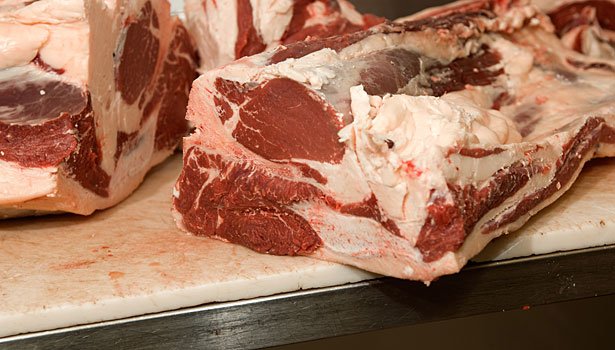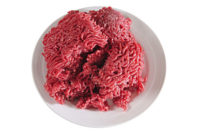Regulations & Legislation
FSIS clarifies, expands routine trim sampling

 On Dec. 13, 2013, the Food Safety and Inspection Service (FSIS) issued Notice 81-13 to clarify and expand its routine trim sampling programs. Inspection program personnel (IPP) were to implement this notice beginning Jan. 5, 2014, with updating the plant profile so that sampling tasks can be appropriately scheduled.
On Dec. 13, 2013, the Food Safety and Inspection Service (FSIS) issued Notice 81-13 to clarify and expand its routine trim sampling programs. Inspection program personnel (IPP) were to implement this notice beginning Jan. 5, 2014, with updating the plant profile so that sampling tasks can be appropriately scheduled.
Background
Under existing programs (at presstime, prior to the Jan. 5, 2014, implementation date), FSIS currently samples raw beef intended for use in non-intact products. Under the MT60 program, FSIS samples raw materials intended for non-intact use for E. coli O157:H7 and the six non-O157 STEC if the materials are generated at the establishment from its own slaughter production. Under the MT55 program, FSIS samples raw materials intended for raw non-intact use for
E. coli O157:H7 from materials generated at non-slaughter establishments.
As designed, these programs did not expressly address situations where primal or subprimal cuts were sold by slaughters for intact use, but were being used “as is” by further processors to make ground or other non-intact products. FSIS noted under that program, that primal/subprimals “would likely not be sampled at the slaughter establishment if the slaughter establishment indicated that the products are intended for raw intact use.” Moreover, these products were unlikely to be sampled at the processing establishment if the establishment did not “process” the subprimals before making non-intact product. During an audit, the USDA Office of Inspector General determined that primals and subprimals used in non-intact products may not be sampled. In response, FSIS developed Notice 81-13.
Notice 81-13
The notice has two related purposes: (1) clarify that primals/subprimals are to be sampled if/when intended for raw non-intact use, and (2) clarify/expand the products deemed to be non-intact.
The products deemed non-intact include products covered by the standard for “miscellaneous beef products,” 9 CFR § 319.15 (such as ground beef or patties); products similar to the standard; shaped and formed raw ground products; raw ground beef meat fillings/sauces/soups; raw beef sausages; and last, but not least, raw mechanically tenderized products. Please note, FSIS is not announcing that all these finished products will be tested by the agency, only that the raw materials used to make such products will be subject to testing under MT60 or MT55.
Sampling
The IPP are to collect samples of:
- Trim (primals/subprimals intended for non-intact use) generated at a slaughter establishment under MT60.
- Trim (including primals, subprimals and boxed beef) generated or used “as is” at a non-slaughter establishment or trim purchased by a slaughter establishment under MT55.
On mechanically tenderized products, FSIS intends the sample be taken after all interventions have been applied, but before the product is tenderized, if that can be done safely. When possible, establishments may consider running the raw materials through the process at time of sampling, but turn the tenderization equipment cabinet off. This could minimize cleaning/sanitizing after the sample is taken.
FSIS intends on analyzing 2,800 samples under the MT60 program and 1,440 under the MT55 program in fiscal year 2014.
Directive 10,010.1 still applies
The existing rules on STEC sampling contained in Directive 10,010.1, Rev. 3 continue to apply to sampling, such as:
- Lotting — FSIS recognizes that a single package of primals/subprimals can be the lot implicated by a sample, provided the determination is supportable, such as through a combination of purchase specifications, interventions, and minimizing commingling of product.
- N-60 sampling — The IPP are to take 60 samples from the lot. Should the lot be defined as one cryovac package of subprimals, the IPP would take the 60 samples from the individual product in that package.
- Sampling at the start of production — If an establishment maintains a production schedule so that it is possible to determine what products would be produced at a specific time of day, once the IPP have selected the random time for sampling, the establishment could run the products scheduled for that selected time at the beginning of production to minimize product implicated by a sample.
Regulatory actions following positives
If there is a positive MT60, the IPP are to conduct: (1) a directed HACCP-verification task for the specific production lot that tested positive; (2) a directed Sanitation SOP task to review the records for the day(s) the product was produced; and (3) a directed Beef Sanitary Dressing task. FSIS would conduct follow-up sampling at the establishment.
With a positive MT55, the IPP at the purchaser would conduct: (1) a directed HACCP-verification task for the specific production lot that tested positive; and (2) a directed Sanitation SOP task to review the records for the day(s) the product was produced.
In addition, with an MT55, the agency would go back to the supplying establishment and have IPP at the supplier conduct: (1) a directed HACCP-verification task for the specific production lot that tested positive; (2) a directed Sanitation SOP task to review the records for the day(s) the product was produced; and (3) a directed Beef Sanitary Dressing task. If there is a positive MT55, “FSIS would not typically request the recall of source materials from suppliers of the bench trim that FSIS sampled and found positive.”
FSIS would conduct follow-up sampling.
Looking for a reprint of this article?
From high-res PDFs to custom plaques, order your copy today!








